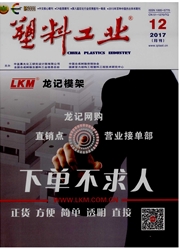

 中文摘要:
中文摘要:
以市售壳聚糖、自制水溶性壳聚糖和微米化壳聚糖为抗菌剂,LDPE为基体,通过机械混炼法制备了系列抗菌塑料,考察了各种壳聚糖用量对抗菌塑料断裂伸长率的影响以及其对E.coli、B.subtilis和P.species的抑菌效果。结果表明,各种壳聚糖的加入均使LDPE的断裂伸长率降低,当壳聚糖:LDPE〉0.5:100(质量比)后,下降缓慢;各抗菌塑料对三种供试细菌的抑菌效果不同,以水溶性壳聚糖为抗菌剂所得产物对B.subtilis的抑制效果最好,而抗菌剂用量对抗菌率的影响不大。6周土壤掩埋实验表明,添加壳聚糖会使LDPE抵抗自然环境中微生物侵蚀的能力降低。
 英文摘要:
英文摘要:
With commercial chitosan, self-made water-soluble chitosan and micro-chitosan as antibacterial agents, LDPE as matrix, a series of low density polyethylene (LDPE) antibacterial functional plastics was prepared by means of mechanical blending. The effects of different chitosan contents on the elongation at break of the an- tibacterial LDPE were tested, and the bacteriostatic effects of the prepared antibacterial LDPE against E. coli, B. subtilis and P. species were investigated. The results indicated the elongation at break of the LDPE with antibacterial decreased, which had a slower decline when the mass ratio of the chitosan and LDPE was higher than 0. 5: 100. The prepared antibacterial LDPE showed different antibacterial effects against the three experimental strains, and the composites with water-chitosan exhibited the best bacteriostatic effect against B. subtilis, however, the content of the antibacterial agent had little effect on the antibacterial ratio. Moreover, 6-weeks soil burial test im- plicated the addition of chitosan would cause the decrease of the resistance of LDPE to microbiological deterioration in natural environment.
 同期刊论文项目
同期刊论文项目
 同项目期刊论文
同项目期刊论文
 期刊信息
期刊信息
